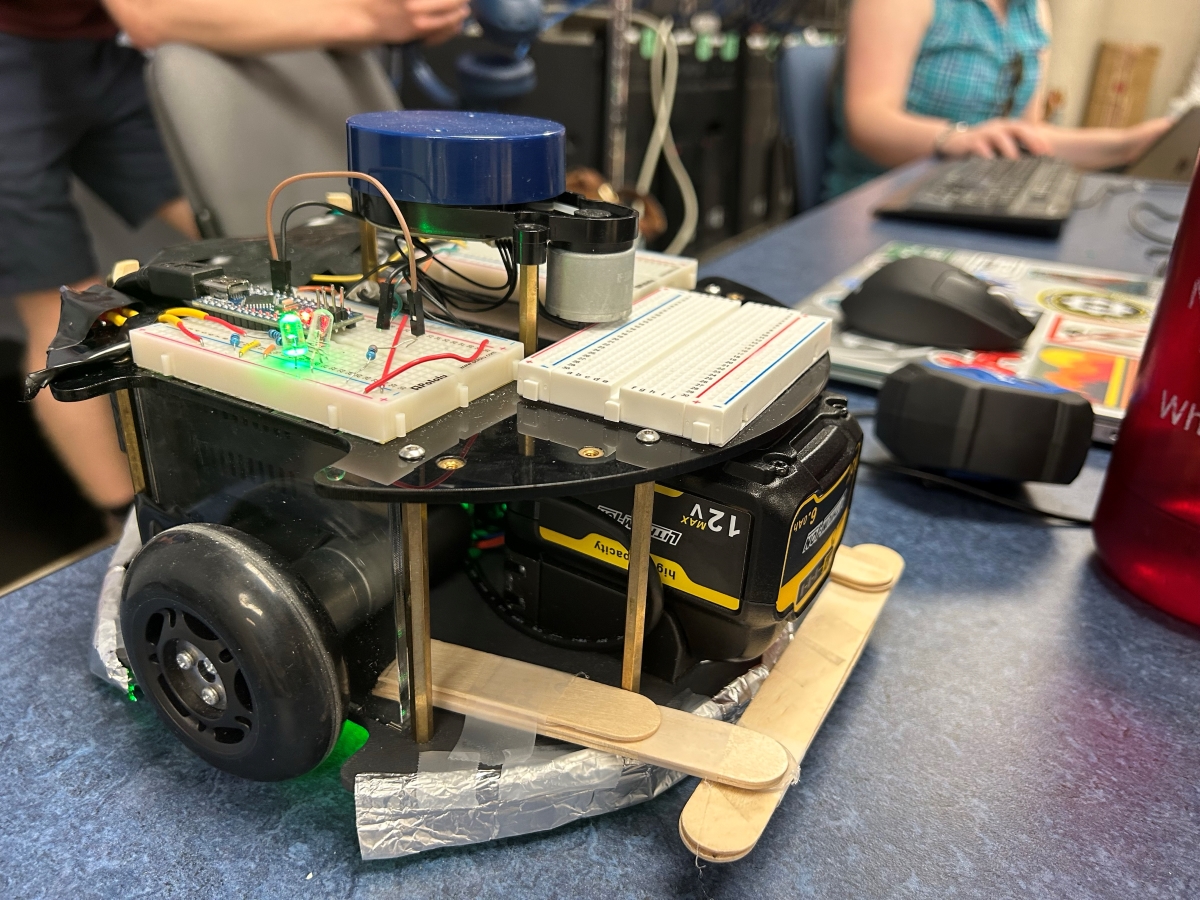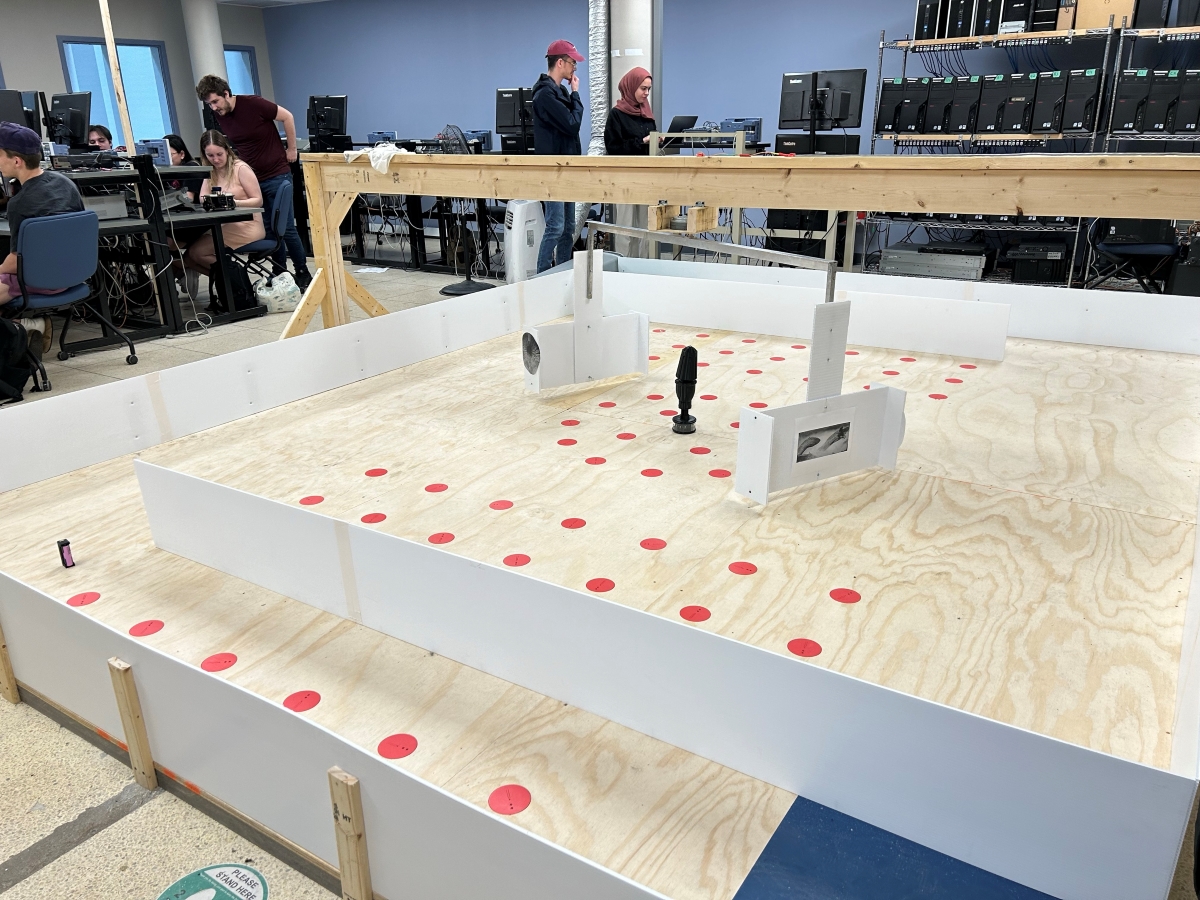News
» Go to news mainHands‑On Learning in Action: Students Gear Up for Peter Gregson Robotics Design Competition

Third-year electrical engineering students huddle together in their Design II course, applying the finishing touches to their autonomous robots. The students are gearing up for the Peter Gregson Robotics Design Competition.
Among the 19 teams competing in this Friday’s event are Amy Kehoe, Kai Tia, Cameron Archibald, Alex Cross, and Gregor Deveau. Their team has built a robot named Ian. Measuring just 9 inches in diameter, Ian has two wheels, a motor, a mounted LiDAR that spins as he moves, and popsicle sticks that serve as bumpers.
“We’ve only really been working on the robot itself for the last couple of weeks,” says Kehoe, explaining the complexities of building and programming their robot for competition.
Peter Gregson Robotics Design Challenge
The annual Peter Gregson Robotics Design Challenge is a highlight for third-year electrical engineering students. Each year, students enrolled in the Design II course are given a theme and set of rules for the competition. While the specific tasks change from year to year, the objective remains the same: to design an autonomous robot capable of seamlessly navigating an obstacle course.

This year’s theme, "The Battle for Arrakis," is inspired by the science fiction film "Dune."
Two robots at a time will face off, navigating an obstacle course filled with “spice pucks.” Each puck contains a photo sensor that registers light frequency, awarding points when robots trigger them with their team’s corresponding frequency. At the center of the course are two moving “worms” guarding special spice worth extra points. The robot must travel through the course, avoid obstacles, and collect as many points as possible without incurring penalties for hitting walls or worms. “At the end, the points are tallied. Whoever wins will go to the next round,” says Kehoe. “It’s a double elimination tournament, so the loser will drop down to the losing bracket and then can fight their way back up. If you lose twice, you’re out.”
The Learning Curve
While third-year electrical engineering students eagerly anticipate their chance to compete each year in the event, Kehoe notes that the learning curve involved in building and coding an autonomous robot can be challenging. “In our past design courses, we usually use microcontrollers with limited capacity and directly program what the robot is expected to do, for example, move forward for 10 seconds or until an obstacle is within 15 centimeters of a sensor. This course introduces us to a robot that can make autonomous decisions based on the parameters we set and instructions we provide. It’s an entirely new challenge to develop a set of rules and restrictions that lead to the results we want, rather than providing instructions that guarantee it.”
To support each team, students receive a base robot, a toolkit, and a $300 budget at the start of the semester. From there, they need to program their robots to autonomously navigate the obstacle course while earning as many points as possible. “We code the robot to go from where it starts to the end of the map,” says Kehoe. “This took a lot of trial and error, and we changed how we did it partway through. The robot would get stuck and stop moving, and we weren’t sure why. It didn’t always happen, and we couldn’t really figure out what was going on. As we have spent more time working with the system, we’ve narrowed down possible causes and keep incrementally improving the code to make it less frequent. Additionally, we used a slightly different navigation method to help prevent delays in our code.”

While the pressure to win the robotics competition weighs on each team’s mind, the experience of participating in the Peter Gregson Robotics Design Competition extends beyond the thrill of the event. “The idea of taking a task, breaking it down, and solving it—that’s engineering,” says Kehoe. She emphasizes that the best part of the challenge is not only the opportunity to gain hands-on experience outside the classroom but also the chance to bond with classmates. “If one team figures out the solution to a problem that everyone is having trouble with, they have been good enough to at least give us some sort of hint in the right direction,” Kehoe adds. “We are all one class, and we are all trying to learn this stuff together.”
Come Friday, however, it’s every team for themselves, battling it out on the obstacle course to see whose robot will prevail.
“All five of us have put a lot of work into different subsystems of our robot. For the next few days, we’ll continue to refine them and integrate them. On Friday though, it’ll all be up to Ian.
Recent News
- 2025 Engineering Golf Tournament
- In Memoriam — Dr. J. Pemberton Cyrus, PEng, FEC
- Dealing with Data: Julia Sarty is equally at home in finance and health care
- From Burkina Faso to Canada: An international perspective on life at Dalhousie Engineering
- Dr. Craig Lake Receives Sexton Award for Teaching Excellence
- Creating Space and Support for Women in Engineering at Dal
- Grad profile: Shipped with purpose
- Megan Bellemare: A Journey Through Chemical Engineering
